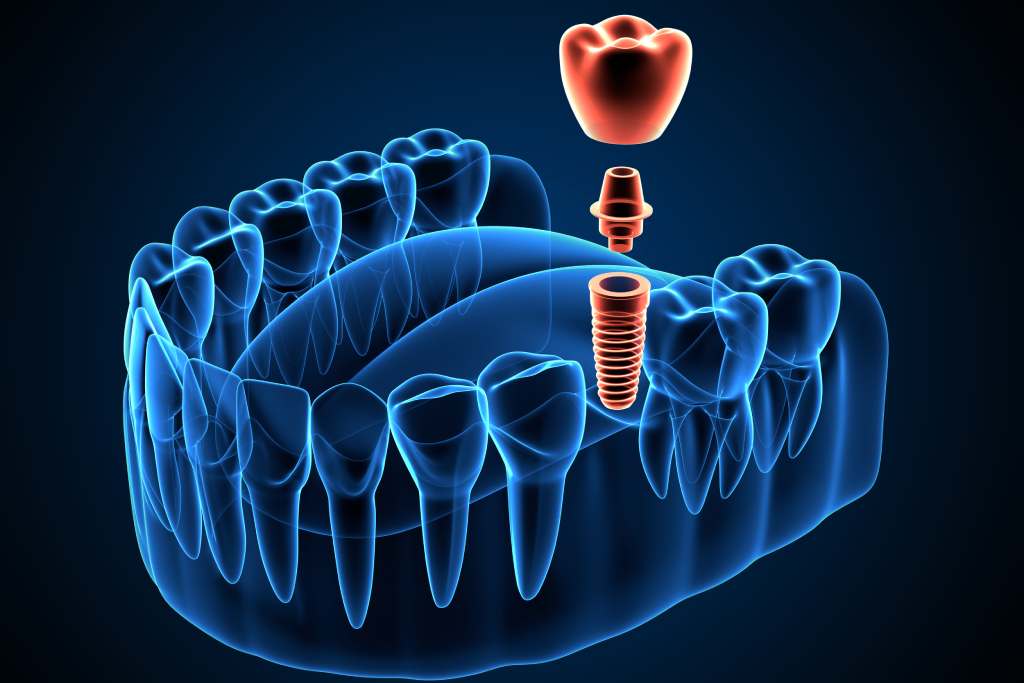Dental Implants
Types of Dental Implants
Full Size
A full-sized dental implant, measuring 3mm or larger in diameter, offers an optimal solution for individuals with missing teeth due to various reasons such as injury, periodontal disease, or other causes. Constructed from titanium, a dental implant is a metal post meticulously placed into the jawbone. Once positioned and allowed time for the surrounding bone to fuse with the implant’s microscopic pores, a replacement tooth is custom-designed, crafted, and affixed to the implant using a threaded screw. While dental implants generally incur higher costs compared to alternative tooth replacement methods, they offer unparalleled advantages. Implants boast greater strength than natural teeth and typically have a longer lifespan than traditional bridge work. Additionally, they present a more advantageous option over bridgework as they don’t rely on neighboring teeth for support.
Mini Implants
Mini implants are easier to place and also cost less than full-size implants. Mini implants (1.8 to 2.9 mm in diameter) work best for replacing front teeth or bicuspid (non-molar) teeth to support a crown. Four mini implants can also be used to support and stabilize a lower denture. This is now the standard of care and what I would want. Four small housings with O rings are placed on the small ball on top of the implant. Next, the housings are bonded inside the denture base. Often, implants and housings are completed at the same appointment. If the bone is too soft for immediate loading, the O rings are not placed in the denture for a few months. This allows the bone to adapt or integrate into the implant for a few months before loading the implants. You will then enjoy a stable lower denture, giving you the confidence to smile, speak, and eat.
For implant candidacy, it’s essential to have healthy gums and sufficient bone structure to support the implant securely. Moreover, dedication to maintaining excellent oral hygiene and attending regular dental check-ups is crucial for long-term dental implant success.
Dr. Fordice is a dedicated doctor who pays extraordinary attention to detail. He has completed advanced training in the restoration and placement of implants in order to ensure that he will provide only the best results for you. Dr. Fordice also implements today’s best implant technologies in our office, solidifying our place as dental implant experts.
Dental Implants
Learn about the Dental Implant Process
To demystify the dental implant process, we break it down into clear and comprehensible steps, ensuring a better understanding of the procedure.

Initial
Consultation
We begin by conducting a thorough examination of your mouth to assess whether dental implants are suitable for you. This visual check allows us to evaluate your oral health and determine the feasibility of implants. Additionally, a 3D cone beam scan is performed to provide a detailed visualization of the bone structure, enabling us to assess the quantity and quality of the bone available to support the implant.

Treatment
Planning
Based on the information gathered from the examination and scan, we develop a comprehensive treatment plan tailored to your specific needs. This plan outlines the number of implants required, their optimal placement, and any additional procedures that may be necessary, such as bone grafting or tooth extractions.

Implant
Placement
With the treatment plan in place, we proceed with the surgical placement of the dental implants. This procedure involves creating a small incision in the gum tissue, preparing the jawbone, and precisely inserting the implant into the designated location. In some cases, immediate implant placement may be possible after tooth extraction.

Healing
Period
- After the implant placement, a healing period is necessary to allow osseointegration to occur. Osseointegration is the process by which the dental implant fuses with the surrounding bone, creating a strong and stable foundation for the restoration. This healing phase typically takes a few months, during which temporary restorations may be provided if needed.

Restoration
Placement
Once the implant has successfully integrated with the jawbone, we move forward with the placement of the dental restoration. This can be a crown, bridge, or denture, depending on the number of missing teeth and your treatment plan. The restoration is custom-designed to blend seamlessly with your natural teeth, providing both functionality and aesthetics.

Follow-up
Care
Regular follow-up appointments are essential to monitor the healing progress and ensure the long-term success of your dental implants. We will provide guidance on oral hygiene practices and schedule periodic check-ups to maintain the health and longevity of your implants.
By outlining each step of the dental implant process, we aim to alleviate any concerns or uncertainties, empowering you to make informed decisions about your oral health and well-being.
Dental Implants
Recovery, Follow-up & Aftercare
The recovery process for dental implants is influenced by several factors, including the completion of necessary treatment procedures.
Oral Hygiene
Maintaining diligent oral hygiene habits is crucial for ensuring the successful integration of dental implants with the surrounding bone structure.
Flossing & Brushing
Improper flossing and brushing leads to treatment failure. Infection risks rise without proper cleaning around the implant.
Healing
Implant placement surgery healing spans up to six months, with crown fitting and seating requiring an additional two months.
